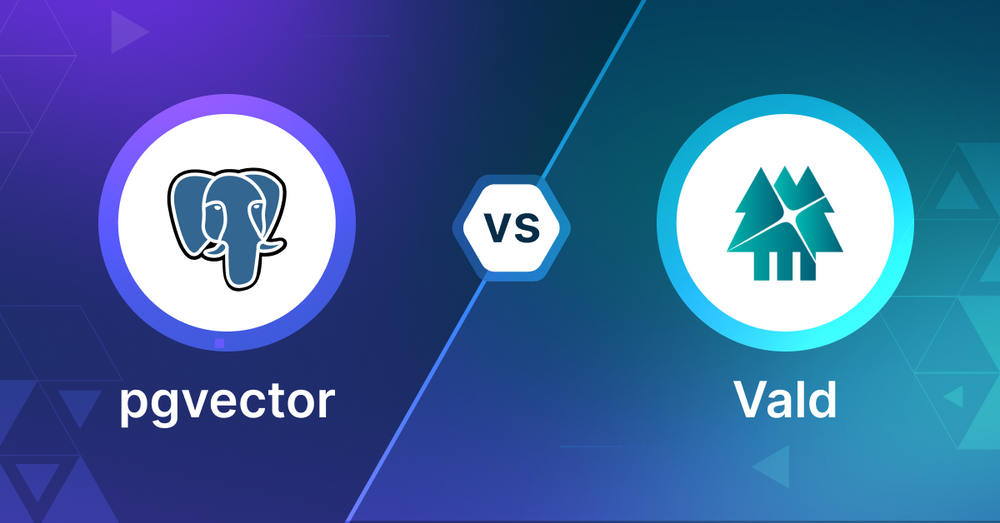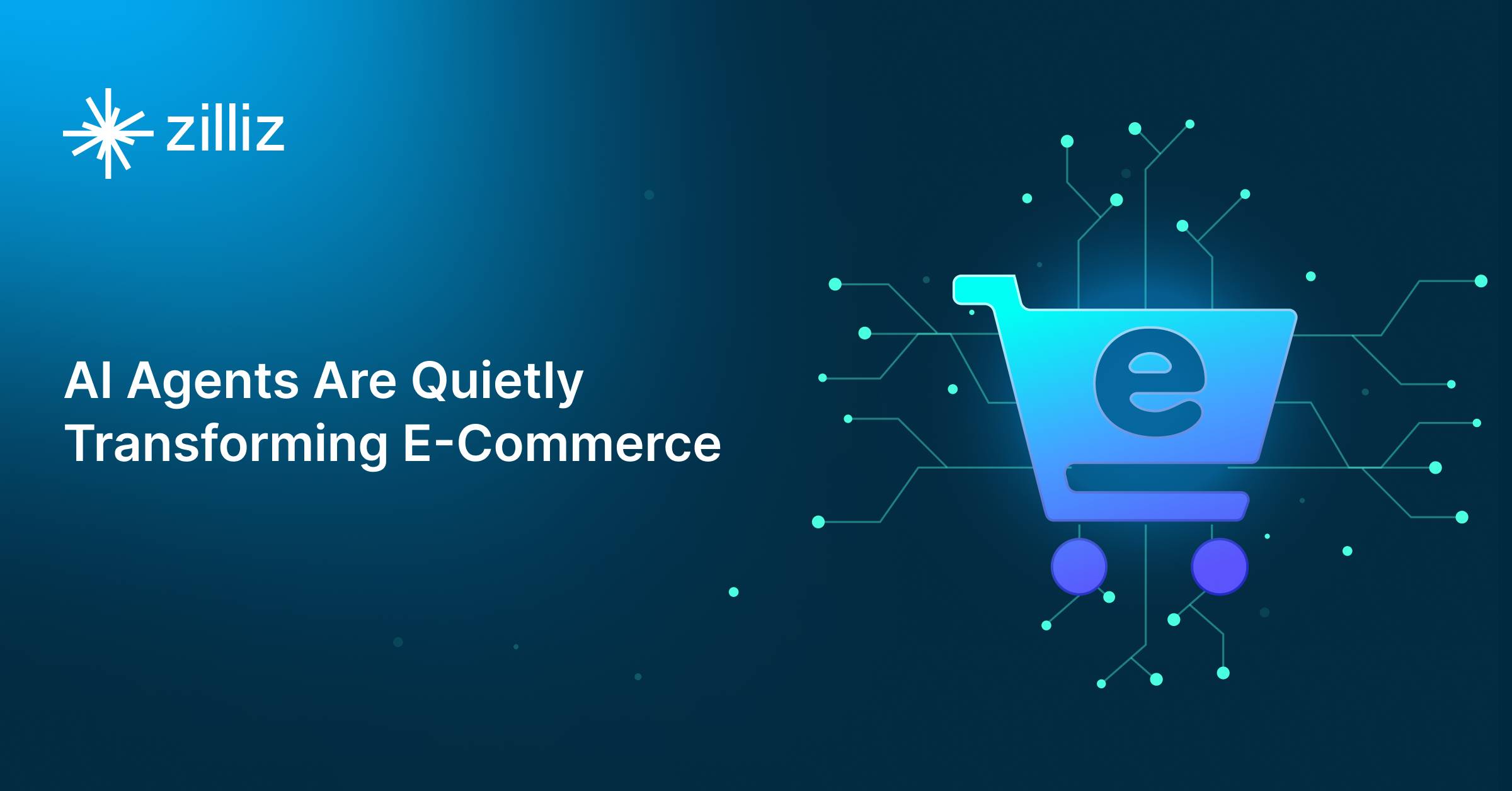pgvector vs Vald: Choosing the Right Vector Database for Your Needs

As AI and data-driven technologies advance, selecting an appropriate vector database for your application is becoming increasingly important. pgvector and Vald are two options in this space. This article compares these technologies to help you make an informed decision for your project.
What is a Vector Database?
Before we compare pgvector and Vald, let's first explore the concept of vector databases.
A vector database is specifically designed to store and query high-dimensional vectors, which are numerical representations of unstructured data. These vectors encode complex information, such as the semantic meaning of text, the visual features of images, or product attributes. By enabling efficient similarity searches, vector databases play a pivotal role in AI applications, allowing for more advanced data analysis and retrieval.
Common use cases for vector databases include e-commerce product recommendations, content discovery platforms, anomaly detection in cybersecurity, medical image analysis, and natural language processing (NLP) tasks. They also play a crucial role in Retrieval Augmented Generation (RAG), a technique that enhances the performance of large language models (LLMs) by providing external knowledge to reduce issues like AI hallucinations.
There are many types of vector databases available in the market, including:
- Purpose-built vector databases such as Milvus, Zilliz Cloud (fully managed Milvus), and Weaviate
- Vector search libraries such as Faiss and Annoy.
- Lightweight vector databases such as Chroma and Milvus Lite.
- Traditional databases with vector search add-ons capable of performing small-scale vector searches.
pgvector is a traditional database with vector search capabilities as an add-on. Vald is a purpose-built vector database. This post compares their vector search capabilities.
pgvector: Overview and Core Technology
pgvector is an extension for PostgreSQL that adds support for vector operations. It allows users to store and query vector embeddings directly within their PostgreSQL database, providing vector similarity search capabilities without the need for a separate vector database.
Key features of pgvector include:
- Support for exact and approximate nearest neighbor search
- Integration with PostgreSQL's indexing mechanisms
- Ability to perform vector operations like addition and subtraction
- Support for various distance metrics (Euclidean, cosine, inner product)
pgvector, by default, employs exact nearest neighbor search, which guarantees perfect recall but can be slower for large datasets. To optimize performance, pgvector offers the option to create indexes for approximate nearest neighbor search. This approach trades some accuracy for significantly improved speed, which is often a worthwhile tradeoff in many real-world applications.
It's important to note that adding an approximate index can change the results of your queries. This is different from typical database indexes, which don't affect the actual results returned. The two types of approximate indexes supported by pgvector are:
- HNSW (Hierarchical Navigable Small World): Introduced in pgvector version 0.5.0, HNSW is known for its high performance and quality of results. It builds a multi-layer graph structure that allows for fast traversal during searches.
- IVFFlat (Inverted File Flat): This method divides the vector space into clusters. During a search, it first identifies the most relevant clusters and then performs an exact search within those clusters. This can significantly speed up searches in large datasets.
The choice between these index types depends on your specific use case, considering factors like dataset size, required query speed, and acceptable trade-off in accuracy. HNSW generally offers better performance but may use more memory, while IVFFlat can be more memory-efficient but might be slightly slower or less accurate in some cases.
When implementing pgvector in your project, try to experiment with both index types and their parameters to find the optimal configuration for your specific needs. This process of fine-tuning can impact the performance and accuracy of your vector search operations.
Wanna learn how to get started using pgvector? Check out this tutorial!
Vald: Overview and Core Technology
Vald is a powerful tool for searching through huge amounts of vector data really fast. It's built to handle billions of vectors and can easily grow as your needs get bigger. The cool thing about Vald is that it uses a super quick algorithm called NGT to find similar vectors.
One of Vald's best features is how it handles indexing. Usually, when you're building an index, everything has to stop. But Vald is smart - it spreads the index across different machines, so searches can keep happening even while the index is being updated. Plus, Vald automatically backs up your index data, so you don't have to worry about losing everything if something goes wrong.
Vald is great at fitting into different setups. You can customize how data goes in and out, making it work well with gRPC. It's also built to run smoothly in the cloud, so you can easily add more computing power or memory when you need it. Vald spreads your data across multiple machines, which helps it handle huge amounts of information.
Another neat trick Vald has is index replication. It stores copies of each index on different machines. This means if one machine has a problem, your searches can still work fine. Vald automatically balances these copies, so you don't have to worry about it. All of this makes Vald a solid choice for developers who need to search through tons of vector data quickly and reliably.
Key Differences
Search Performance and Methodology
pgvector offers exact and approximate nearest neighbor search through HNSW and IVFFlat indexes. HNSW is generally faster but uses more memory. Vald uses NGT (Neighborhood Graph and Tree) for approximate nearest neighbor search, designed for high-dimensional vector data.
Data Management
pgvector integrates with PostgreSQL so you can store vectors along with regular data. This is perfect for applications that need both vector and traditional database operations. Vald is a standalone distributed system optimized for pure vector operations at scale.
Scalability
pgvector inherits PostgreSQL's vertical scaling but has limited horizontal scaling. Vald excels here - it's designed for distributed systems, with automatic sharding, replication and live index updates across multiple nodes.
Integration Ease
pgvector is a breeze if you're already using PostgreSQL. It's just an extension install. Vald requires more setup but has flexible integration through gRPC and various plugins.
Cost Analysis
pgvector costs mirror your PostgreSQL infrastructure. If you're already running PostgreSQL, adding pgvector is minimal additional cost. Vald may require dedicated infrastructure but its distributed nature can spread the load across cheaper machines.
Choose pgvector
pgvector is for applications that already use PostgreSQL and need vector search with regular database operations. For datasets under 10 million vectors, content management systems that need semantic search and product recommendation engines where SQL matters.
Choose Vald
Vald is for massive vector datasets that need high availability and real-time processing. For large scale image recognition, real-time recommendation engines and systems that need continuous index updates without downtime, especially when scaling across multiple machines.
Conclusion
pgvector has PostgreSQL integration and simple vector operations, Vald has distributed architecture for big data. Choose based on your scale, infrastructure and ops - pgvector for SQL-integrated moderate workloads, Vald for high-availability big data.
Read this to get an overview of pgvector and Vald but to evaluate these you need to evaluate based on your use case. One tool that can help with that is VectorDBBench, an open-source benchmarking tool for vector database comparison. In the end, thorough benchmarking with your own datasets and query patterns will be key to making a decision between these two powerful but different approaches to vector search in distributed database systems.
Using Open-source VectorDBBench to Evaluate and Compare Vector Databases on Your Own
VectorDBBench is an open-source benchmarking tool for users who need high-performance data storage and retrieval systems, especially vector databases. This tool allows users to test and compare different vector database systems like Milvus and Zilliz Cloud (the managed Milvus) using their own datasets and find the one that fits their use cases. With VectorDBBench, users can make decisions based on actual vector database performance rather than marketing claims or hearsay.
VectorDBBench is written in Python and licensed under the MIT open-source license, meaning anyone can freely use, modify, and distribute it. The tool is actively maintained by a community of developers committed to improving its features and performance.
Download VectorDBBench from its GitHub repository to reproduce our benchmark results or obtain performance results on your own datasets.
Take a quick look at the performance of mainstream vector databases on the VectorDBBench Leaderboard.
Read the following blogs to learn more about vector database evaluation.
Further Resources about VectorDB, GenAI, and ML
- What is a Vector Database?
- pgvector: Overview and Core Technology
- Vald: Overview and Core Technology
- Key Differences
- Choose pgvector
- Choose Vald
- Conclusion
- Using Open-source VectorDBBench to Evaluate and Compare Vector Databases on Your Own
- Further Resources about VectorDB, GenAI, and ML
Content
Start Free, Scale Easily
Try the fully-managed vector database built for your GenAI applications.
Try Zilliz Cloud for FreeKeep Reading

Zilliz Cloud Enterprise Vector Search Powers High-Performance AI on AWS
Zilliz Cloud delivers blazing-fast, secure vector search on AWS, optimized for AI workloads with AutoIndex, BYOC, and Cardinal engine performance.

Creating Collections in Zilliz Cloud Just Got Way Easier
We've enhanced the entire collection creation experience to bring advanced capabilities directly into the interface, making it faster and easier to build production-ready schemas without switching tools.

AI Agents Are Quietly Transforming E-Commerce — Here’s How
Discover how AI agents transform e-commerce with autonomous decision-making, enhanced product discovery, and vector search capabilities for today's retailers.
The Definitive Guide to Choosing a Vector Database
Overwhelmed by all the options? Learn key features to look for & how to evaluate with your own data. Choose with confidence.